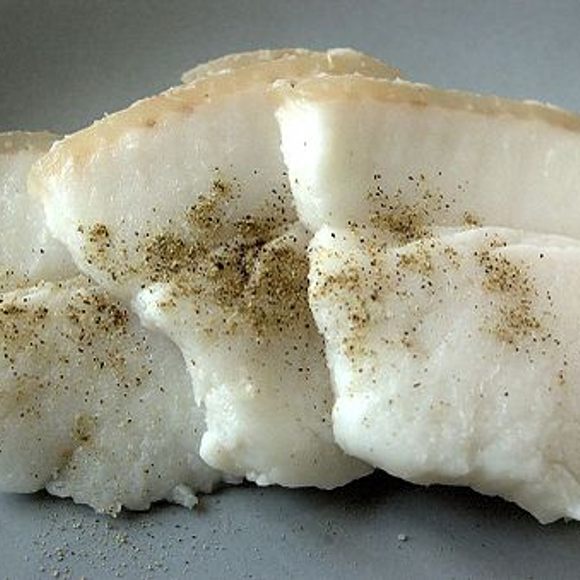Meats & Animal Products
Salo
Usually, the only heat that gets close to this raw pork fat is a sprinkle of pepper.
At first glance, salo, or the cured back fat of a pig, seems like incredibly fatty, uncooked bacon. But most of the time, this popular Ukrainian snack goes nowhere near a frying pan. It’s usually eaten raw.
Sliced thin, salo has a butter-like texture and creamy-white hue. It’s often eaten with a slice of rye bread and copious amounts of black pepper, paprika, or garlic to counter its rich fattiness. A side of pickles or onion provides some welcome crunch.
Salo holds a special place in Ukrainian culture and is considered something of a national dish. In leaner years, it was a filling, long-lasting (salt-curing preserves it for up to two years) source of food. It’s still the perfect food for cold outdoor work. During Ukraine’s Euromaidan protests, the opening sally of 2014’s revolution, street-side kitchens fueled demonstrators with salo on buttered bread and in buckwheat porridge.
Despite cardiovascular disease being a leading cause of death in the country, many Ukrainians maintain that salo is actually healthy, especially for the liver. All the better given that it’s traditional to pair your pork fat with a glass of horilka, or Ukrainian vodka.
In Lviv, Ukraine, there’s even a salo-themed museum and restaurant where chefs have carved the cured fat into heads of state and a massive model of a human heart. Smaller salo sculptures, of faces, lions, and less-tasteful anatomy, are served on plates. Servers even present the creamy fat as a dessert alongside ice cream. But that’s not the only sweet treatment of salo out there. Chocolate-covered salo also exists, wryly called “Ukraine’s Snickers,” to the delight of Ukranian salo fans and the horror of cardiologists.
Where to Try It
-
Salo Art Museum
Svobody avenue, 6/8, Lviv, 79000, UkraineAt this museum/restaurant, there are different varieties (and shapes) of salo to try.
Written By
 Anne Ewbank
Anne Ewbank
Sources
- news.bbc.co.uk/2/hi/europe/3825221.stm
- www.nytimes.com/2013/12/14/world/europe/a-ukrainian-uprising-fueled-by-outrage-and-pork-fat.html
- articles.latimes.com/1995-05-16/news/wr-2285_1_salt-pork
- www.bizarrefood.com/blog/ukrainian-delicacy-salo/
- www.worldbank.org/en/news/feature/2011/06/08/stopping-mortality-crisis-in-ukraine
- ndb.nal.usda.gov/ndb/foods/show/2695?fgcd=&manu=&lfacet=&format=&count=&max=50&offset=&sort=default&order=asc&qlookup=10864&ds=&qt=&qp=&qa=&qn=&q=&ing=
- www.odditycentral.com/pics/worlds-first-pig-fat-museum-opens-in-ukraine.html














